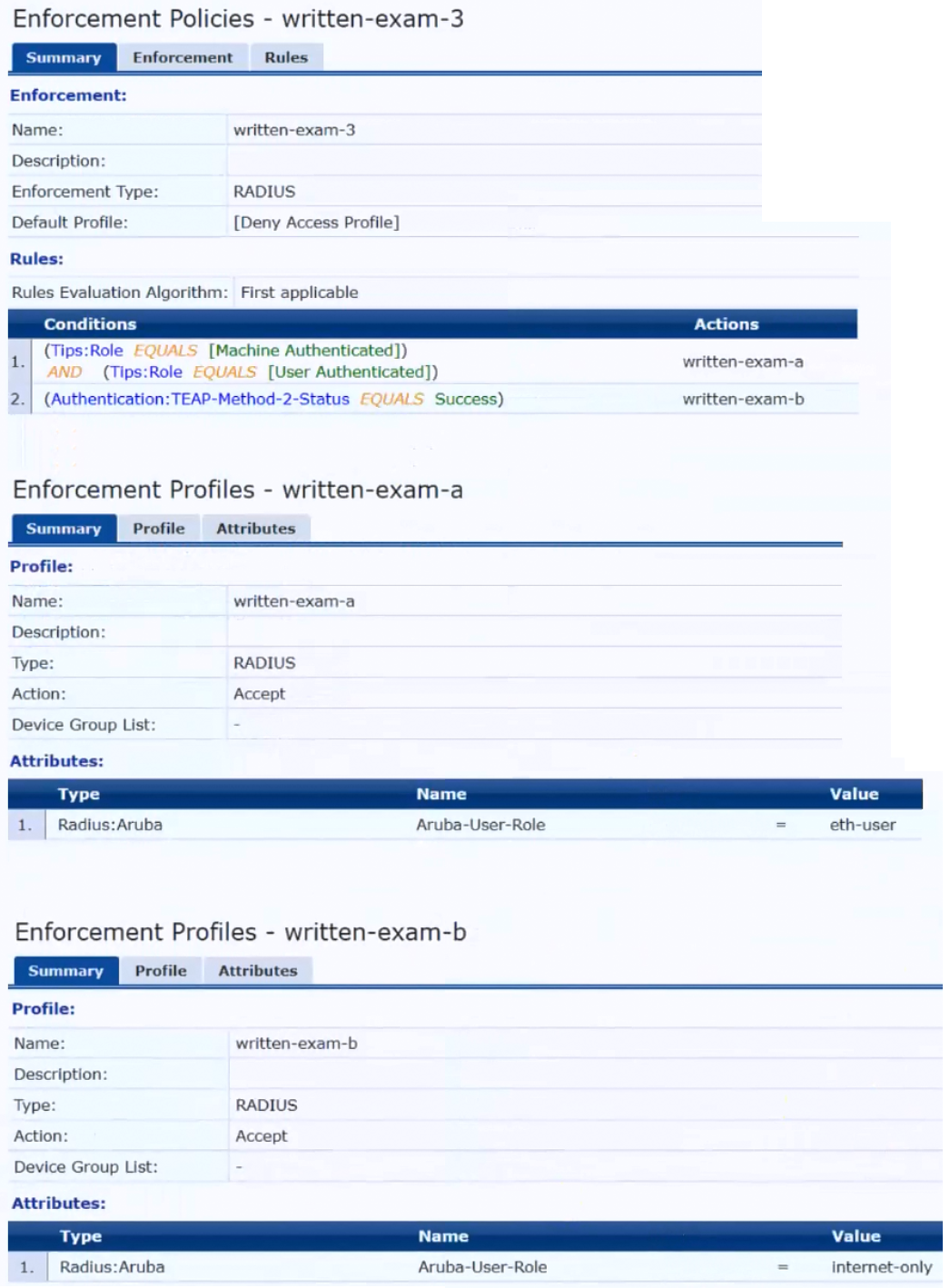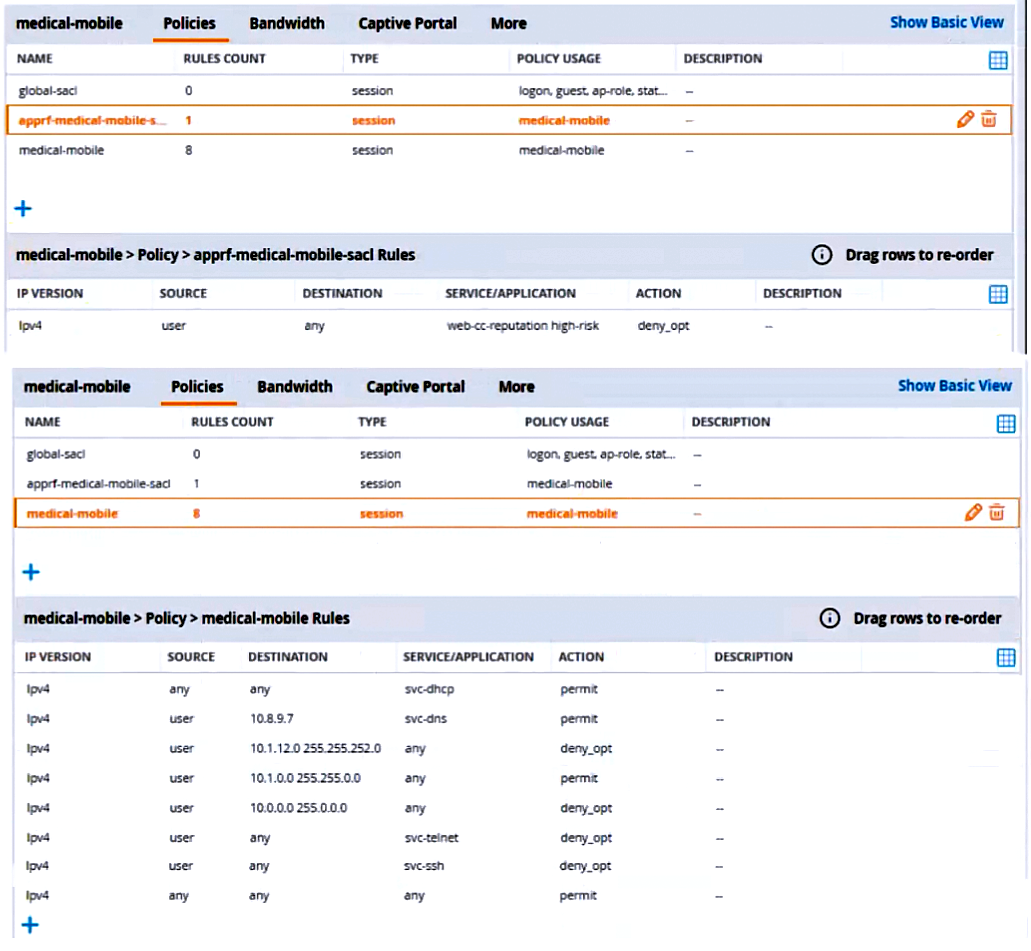HP HPE6-A84 Exam Practice Questions (P. 2)
- Full Access (60 questions)
- Six months of Premium Access
- Access to one million comments
- Seamless ChatGPT Integration
- Ability to download PDF files
- Anki Flashcard files for revision
- No Captcha & No AdSense
- Advanced Exam Configuration
Question #6
Refer to the scenario.
A customer has an Aruba ClearPass cluster. The customer has AOS-CX switches that implement 802.1X authentication to ClearPass Policy Manager (CPPM).
Switches are using local port-access policies.
The customer wants to start tunneling wired clients that pass user authentication only to an Aruba gateway cluster. The gateway cluster should assign these clients to the “eth-internet" role. The gateway should also handle assigning clients to their VLAN, which is VLAN 20.
The plan for the enforcement policy and profiles is shown below:

The gateway cluster has two gateways with these IP addresses:
• Gateway 1
o VLAN 4085 (system IP) = 10.20.4.21
o VLAN 20 (users) = 10.20.20.1
o VLAN 4094 (WAN) = 198.51.100.14
• Gateway 2
o VLAN 4085 (system IP) = 10.20.4.22
o VLAN 20 (users) = 10.20.20.2
o VLAN 4094 (WAN) = 198.51.100.12
• VRRP on VLAN 20 = 10.20.20.254
The customer requires high availability for the tunnels between the switches and the gateway cluster. If one gateway falls, the other gateway should take over its tunnels. Also, the switch should be able to discover the gateway cluster regardless of whether one of the gateways is in the cluster.
Assume that you have configured the correct UBT zone and port-access role settings. However, the solution is not working.
What else should you make sure to do?
A customer has an Aruba ClearPass cluster. The customer has AOS-CX switches that implement 802.1X authentication to ClearPass Policy Manager (CPPM).
Switches are using local port-access policies.
The customer wants to start tunneling wired clients that pass user authentication only to an Aruba gateway cluster. The gateway cluster should assign these clients to the “eth-internet" role. The gateway should also handle assigning clients to their VLAN, which is VLAN 20.
The plan for the enforcement policy and profiles is shown below:

The gateway cluster has two gateways with these IP addresses:
• Gateway 1
o VLAN 4085 (system IP) = 10.20.4.21
o VLAN 20 (users) = 10.20.20.1
o VLAN 4094 (WAN) = 198.51.100.14
• Gateway 2
o VLAN 4085 (system IP) = 10.20.4.22
o VLAN 20 (users) = 10.20.20.2
o VLAN 4094 (WAN) = 198.51.100.12
• VRRP on VLAN 20 = 10.20.20.254
The customer requires high availability for the tunnels between the switches and the gateway cluster. If one gateway falls, the other gateway should take over its tunnels. Also, the switch should be able to discover the gateway cluster regardless of whether one of the gateways is in the cluster.
Assume that you have configured the correct UBT zone and port-access role settings. However, the solution is not working.
What else should you make sure to do?
- AAssign VLAN 20 as the access VLAN on any edge ports to which tunneled clients might connect.
- BCreate a new VLAN on the AOS-CX switch and configure that VLAN as the UBT client VLAN.
- CAssign sufficient VIA licenses to the gateways based on the number of wired clients that will connect.
- DChange the port-access auth-mode mode to client-mode on any edge ports to which tunneled clients might connect.
Correct Answer:
D
D
send
light_mode
delete
Question #7
A company has Aruba gateways and wants to start implementing gateway IDS/IPS. The customer has selected Block for the Fail Strategy.
What might you recommend to help minimize unexpected outages caused by using this particular fall strategy?
What might you recommend to help minimize unexpected outages caused by using this particular fall strategy?
- AConfiguring a relatively high threshold for the gateway threat count alerts
- BMaking sure that the gateways have formed a cluster and operate in default gateway mode
- CSetting the IDS or IPS policy to the least restrictive option, Lenient
- DEnabling alerts and email notifications for events related to gateway IPS engine utilization and errors
Correct Answer:
B
B
send
light_mode
delete
Question #8
A company has Aruba gateways that are Implementing gateway IDS/IPS in IDS mode. The customer complains that admins are receiving too frequent of repeat email notifications for the same threat. The threat itself might be one that the admins should investigate, but the customer does not want the email notification to repeat as often.
Which setting should you adjust in Aruba Central?
Which setting should you adjust in Aruba Central?
- AReport scheduling settings
- BAlert duration and threshold settings
- CThe IDS policy setting (strict, medium, or lenient)
- DThe allowlist settings in the IDS policy
Correct Answer:
B
B
send
light_mode
delete
Question #9
Refer to the scenario.
A customer is migrating from on-prem AD to Azure AD as its sole domain solution. The customer also manages both wired and wireless devices with Microsoft Endpoint Manager (Intune).
The customer wants to improve security for the network edge. You are helping the customer design a ClearPass deployment for this purpose. Aruba network devices will authenticate wireless and wired clients to an Aruba ClearPass Policy Manager (CPPM) cluster (which uses version 6.10).
The customer has several requirements for authentication. The clients should only pass EAP-TLS authentication if a query to Azure AD shows that they have accounts in Azure AD. To further refine the clients’ privileges, ClearPass also should use information collected by Intune to make access control decisions.
Assume that the Azure AD deployment has the proper prerequisites established.
You are planning the CPPM authentication source that you will reference as the authentication source in 802.1X services.
How should you set up this authentication source?
A customer is migrating from on-prem AD to Azure AD as its sole domain solution. The customer also manages both wired and wireless devices with Microsoft Endpoint Manager (Intune).
The customer wants to improve security for the network edge. You are helping the customer design a ClearPass deployment for this purpose. Aruba network devices will authenticate wireless and wired clients to an Aruba ClearPass Policy Manager (CPPM) cluster (which uses version 6.10).
The customer has several requirements for authentication. The clients should only pass EAP-TLS authentication if a query to Azure AD shows that they have accounts in Azure AD. To further refine the clients’ privileges, ClearPass also should use information collected by Intune to make access control decisions.
Assume that the Azure AD deployment has the proper prerequisites established.
You are planning the CPPM authentication source that you will reference as the authentication source in 802.1X services.
How should you set up this authentication source?
- AAs Kerberos type
- BAs Active Directory type
- CAs HTTP type, referencing the Intune extension
- DAS HTTP type, referencing Azure AD's FQDN
Correct Answer:
D
D
send
light_mode
delete
Question #10
Refer to the scenario.
A customer requires these rights for clients in the “medical-mobile” AOS firewall role on Aruba Mobility Controllers (MCs):
Permitted to receive IP addresses with DHCP
Permitted access to DNS services from 10.8.9.7 and no other server
Permitted access to all subnets in the 10.1.0.0/16 range except denied access to 10.1.12.0/22
Denied access to other 10.0.0.0/8 subnets
Permitted access to the Internet
Denied access to the WLAN for a period of time if they send any SSH traffic
Denied access to the WLAN for a period of time if they send any Telnet traffic
Denied access to all high-risk websites
External devices should not be permitted to initiate sessions with “medical-mobile” clients, only send return traffic.
The exhibits below show the configuration for the role.

There are multiple issues with the configuration.
What is one of the changes that you must make to the policies to meet the scenario requirements? (In the options, rules in a policy are referenced from top to bottom. For example, “medical-mobile” rule 1 is “ipv4 any any svc-dhcp permit,” and rule 8 is “ipv4 any any any permit’.)
A customer requires these rights for clients in the “medical-mobile” AOS firewall role on Aruba Mobility Controllers (MCs):
Permitted to receive IP addresses with DHCP
Permitted access to DNS services from 10.8.9.7 and no other server
Permitted access to all subnets in the 10.1.0.0/16 range except denied access to 10.1.12.0/22
Denied access to other 10.0.0.0/8 subnets
Permitted access to the Internet
Denied access to the WLAN for a period of time if they send any SSH traffic
Denied access to the WLAN for a period of time if they send any Telnet traffic
Denied access to all high-risk websites
External devices should not be permitted to initiate sessions with “medical-mobile” clients, only send return traffic.
The exhibits below show the configuration for the role.

There are multiple issues with the configuration.
What is one of the changes that you must make to the policies to meet the scenario requirements? (In the options, rules in a policy are referenced from top to bottom. For example, “medical-mobile” rule 1 is “ipv4 any any svc-dhcp permit,” and rule 8 is “ipv4 any any any permit’.)
- AIn the “medical-mobile” policy, change the source in rule 1 to “user.”
- BIn the “medical-mobile” policy, change the subnet mask in rule 3 to 255.255.248.0.
- CIn the “medical-mobile” policy, move rules 6 and 7 to the top of the list.
- DMove the rule in the “apprf-medical-mobile-sacl” policy between rules 7 and 8 in the “medical-mobile” policy.
Correct Answer:
B
B
send
light_mode
delete
All Pages
